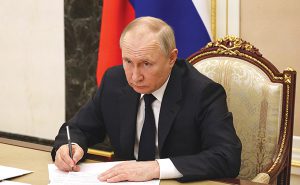The great Nato enlargement debate never ends. In the 1990s, US officials and academics argued about whether pushing the North Atlantic Treaty Organization (Nato) into Eastern Europe was likely to sustain the post-Cold War peace or prematurely end it. More recently, critics have charged that Russia’s war in Ukraine is a natural response to the aggressive expansion of America’s most powerful alliance. Now Russian officials, and even President Vladimir Putin himself, have echoed — and sometimes directly cited — American scholars such as political scientist John Mearsheimer, who argues that the current crisis “is the West’s fault.â€
The “blame Nato†argument tells a story of hubris, arrogance and tragedy. It holds that there was a golden chance for lasting peace in Europe, but the US threw it all away. Rather than conciliating a defeated rival, Washington repeatedly humiliated it by expanding a vast military alliance up to Russia’s borders and even into the former Soviet Union. This pursuit of American hegemony in a liberal-democratic guise eventually provoked a violent rebuke.
In this telling, Putin’s wars against Georgia and Ukraine are just the natural response of one great power whose vital interests are being heedlessly threatened by another. The argument isn’t wholly wrong. Putin’s wars are indeed meant, in part, to push Western influence back from Russia’s frontiers. But the idea that Nato expansion is the root of today’s problems is morally and geopolitically bizarre.
Far from being a historic blunder, Nato expansion was one of the great American successes of the post-Cold War era. Far from being the act of a domineering superpower, it was part of a long tradition of vulnerable states begging to join America’s liberal empire. And far from posing a mortal threat to Moscow, Nato enlargement actually provided Russia with far greater security than it could have provided itself.
Nato was founded in 1949 with 12 members in Western Europe and North America. It gradually added additional states — Turkey, Greece, West Germany, Spain — over the course of the Cold War. But the big bang of enlargement came once the superpower conflict ended. Nato incorporated the former East Germany into the alliance in 1990; it then added three Eastern European countries (Poland, Hungary, the Czech Republic) in 1999; then seven more, including the Baltic states, in 2004.
To understand why NATO grew so rapidly, we have to remember something that nearly everyone has now forgotten: There was no guarantee that Europe would be mostly stable, peaceful and democratic after the Cold War. In fact, many of the analysts who now view Nato expansion as a catastrophe once warned that a post-Cold War Europe could become a violent hellscape.
It wasn’t an outlandish scenario. A reunified Germany might once again try to dominate its neighbors; the old enmity between Moscow and Berlin could reignite. The collapse of Soviet influence in Eastern Europe could liberate those states to pursue long-suppressed territorial claims and nationalist agendas. Ethnic tensions and nuclear proliferation might explode as the Cold War order crumbled. If the US pulled back once the Soviet threat was gone, there would be no extra-European superpower to put out fires on a continent with lots of geopolitical kindling. “The prospect of major crises, even wars, in Europe is likely to increase dramatically,†Mearsheimer predicted in 1990.
Nato enlargement was the logical answer to these fears. Expansion was a way of binding a reunified Germany to the West and surrounding it with democratic allies. Joining Nato required new members to lay aside any revanchist designs, while allowing them to pursue economic and political reforms rather than investing heavily in military capabilities to defend their newly won autonomy. Nato’s move to the east also ensured that Poland and other states that easily could have built nuclear weapons didn’t need to, because they had American protection. Most important, enlargement kept the U.S. firmly planted in Europe, by preventing the centerpiece of the transatlantic relationship from becoming obsolete.
No other initiative could have accomplished these objectives. Partnership for Peace — a series of loose security cooperation agreements with former Soviet-bloc states — didn’t offer the ironclad guarantees that came with Nato membership. (If you want to understand the difference between “security partner†and “Nato ally,†just look at what is happening today to Ukraine, one of the former.)
The idea of creating a pan-European security architecture (one that included Russia) had the same defect, plus it would have given Moscow veto power over the security arrangements of the countries the Soviet Union had so recently dominated.
Only American power and promises could provide stability in Europe, and Nato was the continent’s critical link to the US. Since 1949, Washington had tamped down rivalries between old enemies such as France and Germany, while also protecting them from external threats.
After 1991, Nato expansion took this zone of peace, prosperity and cooperation that had emerged in Western Europe and moved it into Eastern Europe, as well.
The revolutionary nature of this achievement seemed obvious not so long ago. “Why has Europe been so peaceful since 1989?†Mearsheimer asked in 2010. The answer, he acknowledged, was because “America has continued to serve as Europe’s pacifier,†protecting the continent from dangers, within and without.
Today, of course, the critics don’t buy this account. They argue that Nato expansion represented crude power politics, as the US exploited the Soviet collapse to engorge its own empire. What resulted, pundits such as Thomas Friedman contend, was a sort of Weimar Russia — a country whose dignity was affronted, security imperiled and democracy undermined by a harsh, humiliating peace.
—Bloomberg
Hal Brands is a Bloomberg Opinion columnist, the Henry Kissinger Distinguished Professor at Johns Hopkins University’s School of Advanced International Studies, and a scholar at the American Enterprise Institute. Most recently, he is the author of “The Twilight Struggle: What the Cold War Teaches Us About Great-Power Rivalry Todayâ€
 The Gulf Time Newspaper One of the finest business newspapers in the UAE brought to you by our professional writers and editors.
The Gulf Time Newspaper One of the finest business newspapers in the UAE brought to you by our professional writers and editors.

